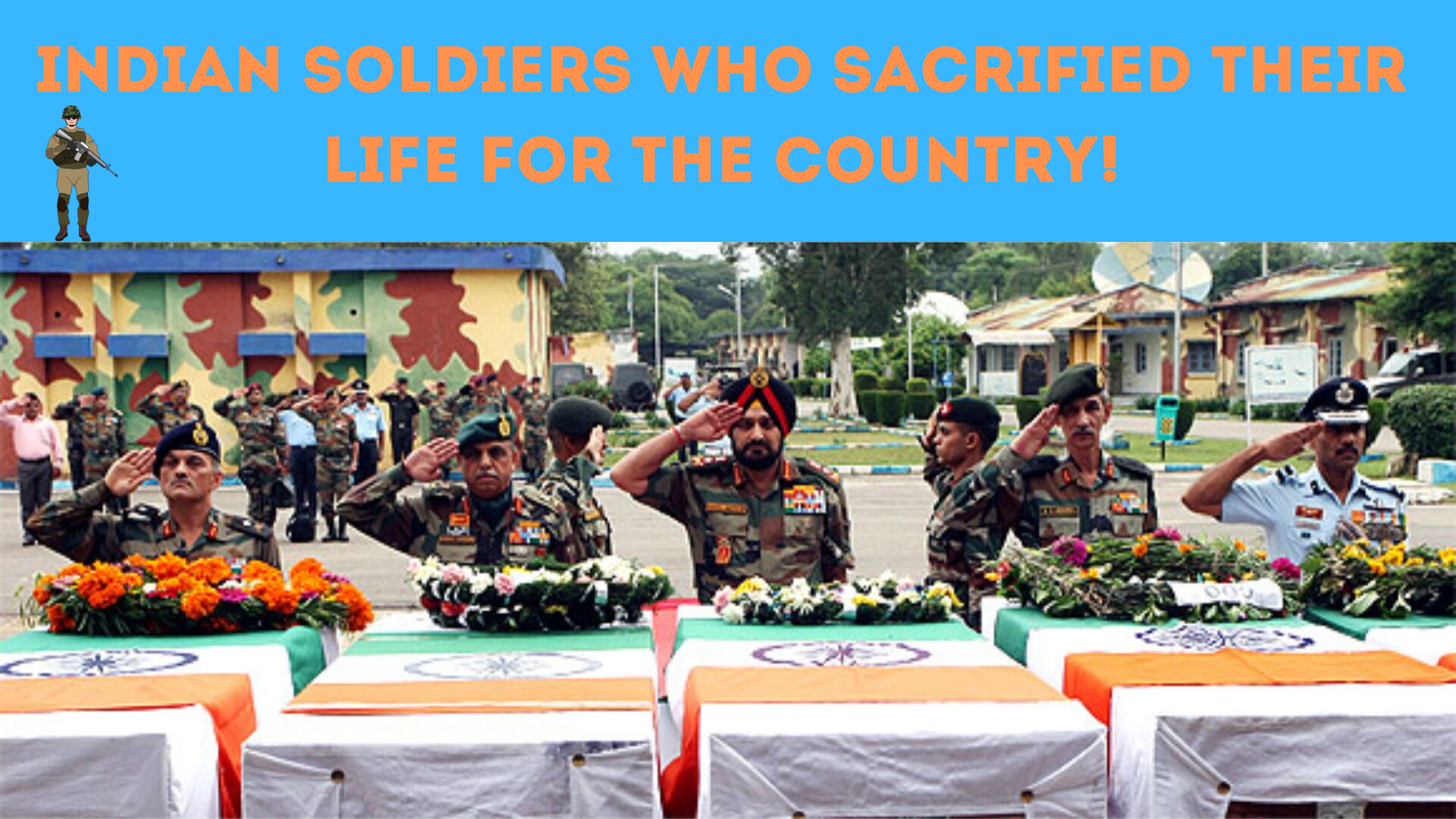“When you go home, tell them of us and say,
for your tomorrow, we gave our today.”
(commemoration on the Kohima war memorial)
August 15, 1947, 72 years ago India was reborn as an independent country, India was reborn as a country free from the British Rule. Independent India was a dream that came true on 15th Of August, 1947, but that was not it. With a newborn India, new challenges also took birth, the challenge to make the country Vishwa guru, and the most important of all the challenges was the challenge to retain the independence of the country and the biggest hurdle to this was the neighbouring and another newly independent country Pakistan. The relation between India and Pakistan is not hidden from anyone in the world either it is cricket, trade or it is the LOC. Saving the country from attacks was the biggest campaign since independence and it is the biggest campaign till now. Indian Armed Forces were the torchbearer of this campaign.
The freedom we celebrate every year was given to us at the cost of the lives of so many soldiers , who have the glory to sacrifice their lives for the independence of the country. They deserve to be remembered not only on independence day or republic day but everyday.
This article celebrates the glory of the bravehearts of the major Indo-Pak Wars starting from the war of 1947 to the Kargil War of 1999.
1. Indo-Pak War, 1947
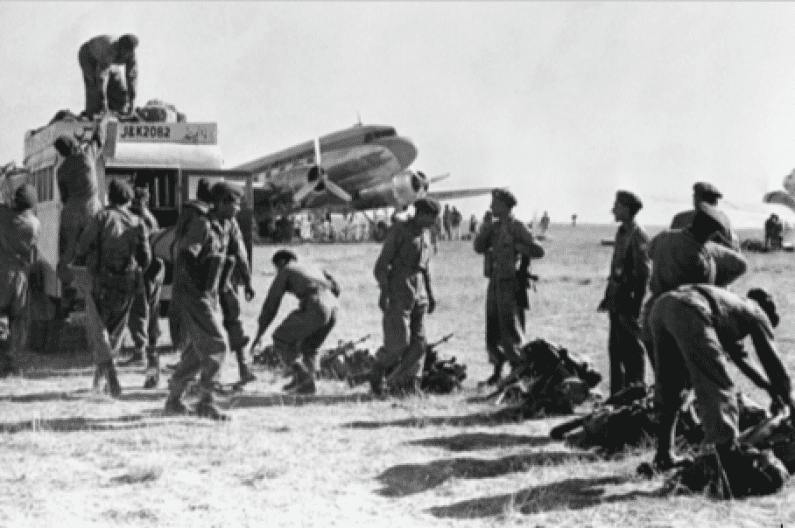
Known as the first Kashmir War , the Indo-Pak war of 1947 was fought between India and Pakistan over the princely state, Jammu and Kashmir. The war started in October 1947 and lasted till January 1949. The war was initiated by Pakistan after few weeks of its independence as Pakistan made efforts to capture Kashmir. Prime Ministers of India and Pakistan during this war were , Jawahar Lal Nehru and Liaquat Ali Khan respectively.The cost of this war was 1,104 martyrs and almost 3200 wounded people.
Some of the bravehearys of this war who sacrificed their lives for the motherland are remembered below :
I. Piru Singh Shekhawat (20 May 1918 – 18 July 1948):
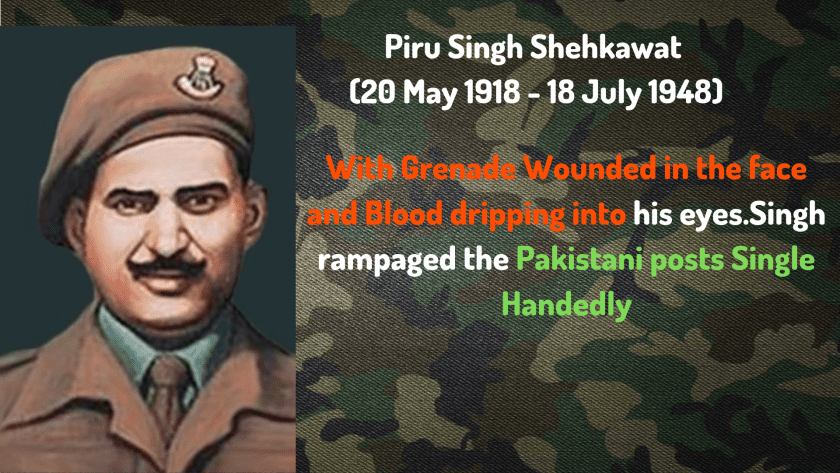
Born on May 20 ,1918 ,in village Beri , Jhunjhunu , Rajasthan , Piru Singh Shekhawat was an Indian Army non-commission officer designated as Company Havildar Major .
Singh was the youngest son of father Lal Singh. Singh was a school dropout and wanted to join the army since childhood . He was rejected twice before being selected in the Indian army at the age of 18. Singh enrolled in the British Indian Army on 20 may 1936 and was assigned to the Ist Punjab Regiment.
After Independence , he took part in the Indo-Pakistani war of 1947. He served with Indian Army’s 6th Rajputana Rifles. On 11 July, the Indian troops commenced their attack. These strikes continued for another four days. But reports regarding the situation suggested that the Pakistanis were still in command of a strategically important position and the Indian commanders decided that these had to be captured before the advance could continue. Apart from this position, another position was also to be captured by the Indians. The task of capturing these two positions was assigned to the 6th Rajputana Rifles. Two companies were assigned to the operation, with the battalion’s ‘C’ Company securing the second position after the first was captured by ‘D’ Company.
During the battle, Singh’s section, leading the company, was sheared down to half strength due to heavy casualties. Singh rushed towards a Pakistani medium machine gun post, which was causing most of the casualties, during which he suffered multiple shrapnel wounds across his body as the Pakistani defenders began rolling grenades down from the heights. Soon he occupied the post killing the men on guard with his bayonet and Sten gun. But by the time he captured the position, the rest of his company lay dead or wounded. Singh was left alone to achieve the objective assigned. He advanced towards the second Pakistani medium machine gun post. At this juncture, he was almost blinded by a grenade that blast at his face. His Sten gun ammunition had run out. Singh moved out of the trench and lobbed grenades at the next Pakistani post. Meanwhile, he jumped into another trench, and killed two Pakistani soldiers with his bayonet. Before he was able to move out of the trench, he was hit by a bullet in his head. As he succumbed to his wounds, Singh hurled a grenade into a nearby Pakistani trench.
Company Havildar Major Piru Singh Shekhawat was awarded with Param Vir Chakra , the highest military decoration of India posthumously , in 1948. India will always be in debt of major Shekhawat.
II. Jadunath Singh (21 November 1916 – 6 February 1948) :
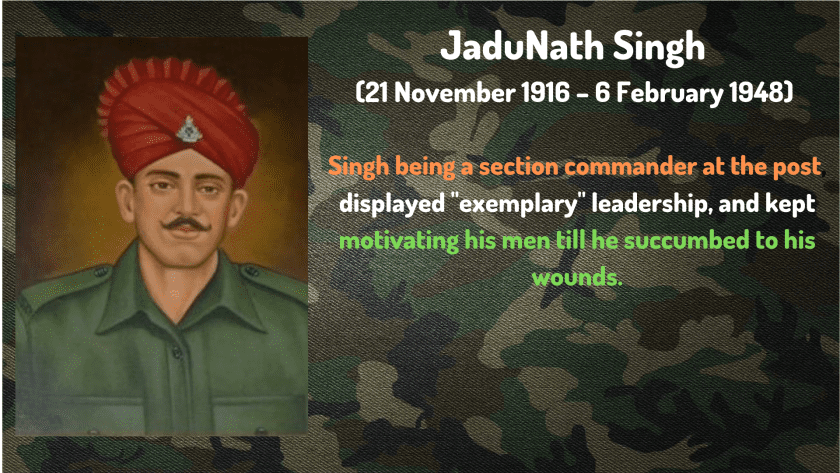
Born on 21 November 1916 in Khajuri village of Shahjahanpur, Uttar Pradesh Naik Jadunath Singh was the son of Birbal Singh Rathore, a farmer, and Jamuna Kanwar. He was the third of eight children, with six brothers and a sister. He could not continue his education further , after fourth standard due to his family’s economic situation. Singh was fond of wrestling , he wrestled and became the wrestling champion of his village.
Singh was enlisted in the British Indian Army in 1941 and served in the Second World War, fighting against the Japanese in Burma. He later took part in the Indo-Pakistani War of 1947 as a member of the Indian Army. In October 1947, following an offensive by the Pakistani raiders in Jammu and Kashmir, the Defence Committee of the Indian Cabinet directed the Army Headquarters to undertake a military response. In one such operation, the 50th Para Brigade, to which the Rajput Regiment was attached, was ordered to secure Naushahra and establish a base at Jhangar in mid-November.
Tain Dhar, lying to the north of Naushahra, was one such approach for which Singh’s battalion was responsible. On the morning of 6 February 1948, Pakistani forces opened fire on pickets from the battalion patrolling along Tain Dhar ridge. Gunfire was exchanged between both sides. The foggy early morning darkness helped the attacking Pakistanis creep up to the pickets. Soon, men in the posts on the Tain Dhar ridge observed a large number of Pakistani soldiers moving towards them. Singh was in command of the nine personnel manning the forward post of the second picket at Tain Dhar. Singh and his section were able to ward off three successive attempts by Pakistani forces to capture their position. By the end of third wave, of the 27 men at the post, 24 were dead or severely wounded. Singh being a section commander at the post, displayed “exemplary” leadership, and kept motivating his men till he succumbed to his wounds.This proved a very critical moment for the battle at Naushahra. In the meantime, Brigadier Usman sent a company of the 3rd (Para) Battalion, Rajput Regiment, to reinforce Tain Dhar.
Singh was posthumously awarded the India’s highest military decoration, the Param Vir Chakra for his actions on 6 February 1948.
Without Singh engaging the Pakistani troops for a considerable period, re-capture of these posts would have been impossible.
III.Somnath Sharma (31 January 1923 – 3 November 1947)
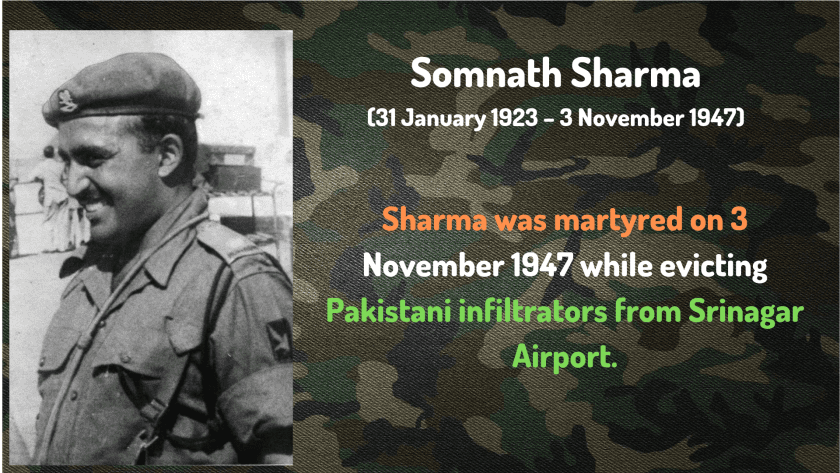
Sharma was born on 31 January 1923 at Dadh, Kangra, then in the Punjab Province of British India, the present day state of Himachal Pradesh. His father, Amar Nath Sharma, was a military officer.[a][3] Several of his siblings served in the military. Sharma completed his schooling at Sherwood College, Nainital, before enrolling at the Prince of Wales Royal Military College in Dehradun. He later studied at the Royal Military College, Sandhurst.[4] During his childhood, Somnath was influenced by the teachings of Krishna and Arjuna in the Bhagavad Gita, taught to him by his grandfather.
On 22 February 1942, upon his graduation from the Royal Military College, Sharma was commissioned into the 8th Battalion, 19th Hyderabad Regiment, of the British Indian Army. During World War II, he saw action against the Japanese in Burma during the Arakan Campaign. At that time he served under the command of Colonel K. S. Thimmayya, who would later rise to the rank of general and become Chief of the Army Staff from 1957 to 1961. Sharma was mentioned in despatches for his actions during the fighting of the Arakan Campaign.
In 1942, Sharma was commissioned into the 8th Battalion, 19th Hyderabad Regiment. He served in Burma during the Arakan Campaign of World War II, for which he was mentioned in despatches. He later fought in the Indo-Pakistani War of 1947. Sharma was martyred on 3 November 1947 while evicting Pakistani infiltrators from Srinagar Airport.
Sharma was posthumously awarded the Param Vir Chakra for his actions prior to his death. On 21 June 1950, Sharma’s award of the Param Vir Chakra, for his actions on 3 November 1947 in defending the Srinagar airport, was gazetted. This was the first time the honour had been awarded since its inception.
2. The Indo- Pakistani War of 1965 :

1965 was the year when many Indian soldiers sacrificed their lives for the people back home, while fighting a war against the aggressor – Pakistani Army. Hostilities had reached a new height between India and Pakistan after the latter’s infiltration into Kashmir that year. India retaliated, which resulted in a full-scale war that went for a month. The war ended on 23 September, 1965 but not before it claimed the lives of more than 3000 Indian soldiers.
Among the martyrs were two men, who inspired generations of patriots, and were awarded with highest Indian medal for gallantry – the Param Vir Chakra (PVC) – for their valour in the war.
I. Company Quarter Master Havildar Abdul Hamid (1 July 1933 – 10 September 1965):
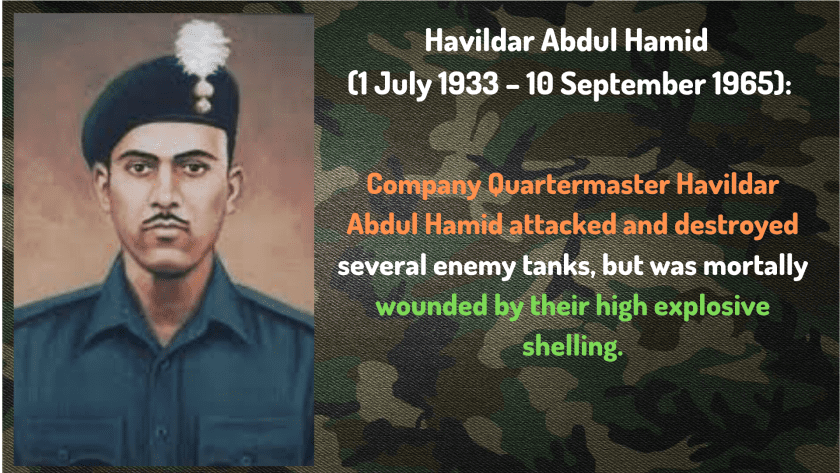
Hamid was born to Sakina Begum and Mohammad Usman in the village of Dhamupur in Ghazipur district , United Provinces, British India on 1 July 1933.
He joined the Grenadiers regiment of the Indian Army on 27 December 1954. Hamid was later posted to the regiment’s 4th Battalion , where he served for the rest of his career.He served with the battalion in Agra, Amritsar, Jammu and Kashmir, Delhi, NEFA and Ramgarh.
Glory was his when the 1965 Indo-Pak war was at its prime. On 10th September, when the Pakistani army penetrated India’s forward position in Khem Karan Sector, Company Quartermaster Havildar Abdul Hamid attacked and destroyed several enemy tanks, but was mortally wounded by their high explosive shelling. Hamid’s brave action inspired his comrades to put up a gallant fight, and to beat back the heavy tank assault by the enemy. Abdul Hamid was known as the tank destroyer .
For his actions at the Battle of Asal Uttar, Hamid was awarded the Param Vir Chakra on 10 September 1965. Other than Param Vir Chakra , Hamid received awards like Samar Seva Star , Raksha Medal and Sainya Seva Medal.
II.Lieutenant Colonel Ardeshir Burzarji Tarapore:
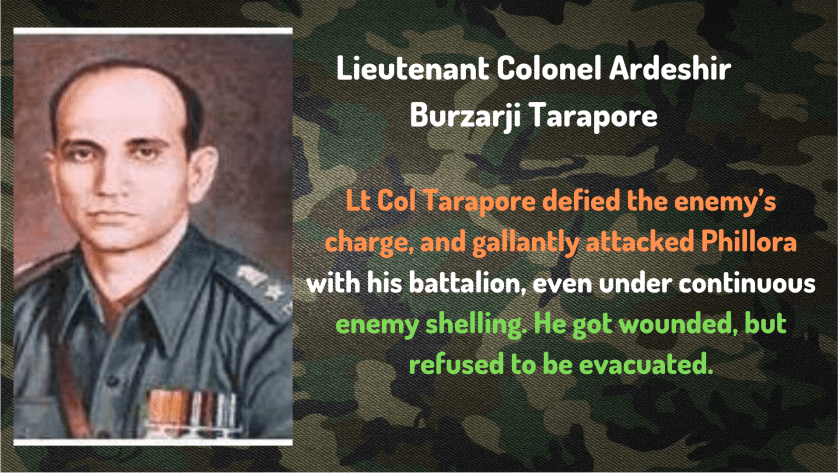
Born in Mumbai in 1923, Tarapore belonged to the family lineage of Chatrapati Shivaji’s General, Ratanjiba. It was almost natural that the boy followed the highest family tradition.
He joined the army as an officer, and glory touched his feet when some of the fiercest tank battles were fought in the history of war between India and Pakistan, in 1965. He got martyrdom and was awarded the Param Vir Chakra.
On 11 September 1965, the Poona Horse Regiment, under the command of Lieutenant Colonel Tarapore, was assigned the task of delivering the main armoured thrust for capturing Phillora in the Sialkot Sector in Pakistan. During the mission, his regiment suddenly came under surprise attack.
Lt Col Tarapore defied the enemy’s charge, and gallantly attacked Phillora with his battalion, even under continuous enemy shelling. He got wounded, but refused to be evacuated. On 14 September 1965, his regiment captured Wazirali, and by 16th, they captured Jassoran and Butur-Dograndi. The enemy lost around 60 tanks in the battle, but Lt. Col Tarapore was mortally wounded in the action.
With India celebrating the 72nd Independence Day on August 15 , 2019 ,it is the perfect time to revisit the stories of extreme sacrifice and valour, to pay true respect to those who fought selflessly for our mother land.
3.Indo-Pakistani War of 1971 :

The Indo-Pakistani War of 1971 was a military confrontation between India and Pakistan that occurred during the liberation war in East Pakistan from 3 December 1971 to the fall of Dacca , present day Dhaka on 16 December 1971. The war began with preemptive aerial strikes on 11 Indian air stations, which led to the commencement of hostilities with Pakistan and Indian entry into the war of independence in East Pakistan on the side of Bengali nationalist forces. It is one of the shortest wars in history , Lasting just 13 days. The war ended after the Eastern Command of the Pakistan military signed the Instrument of Surrender on 16 December 1971 in Dhaka, marking the formation of East Pakistan as the new nation of Bangladesh. Officially, East Pakistan had earlier called for its secession from the unity of Pakistan on 26 March 1971.
Some of the bravehearts of this war who received Param Vir Chakra are listed :;
I. Nirmal Jit Singh Sekhon 17 July 1943 – 14 December 1971)
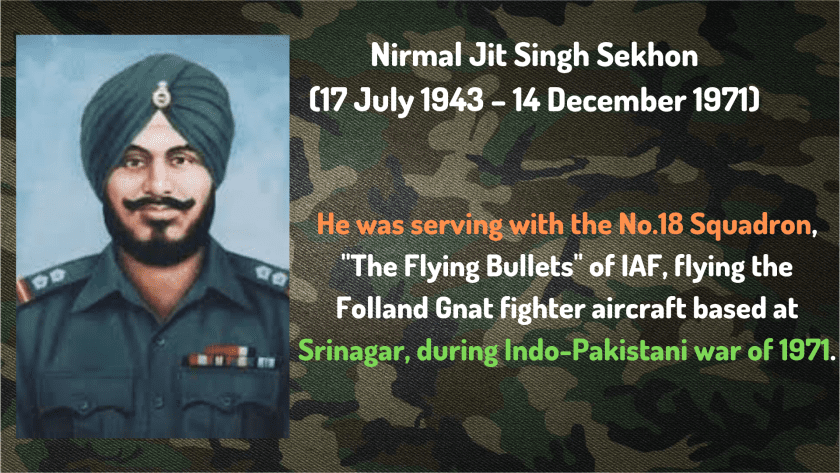
Born on 17 July 1943[3] in the village of Isewal, Ludhiana, Punjab Province, British India , Nirmal Jit Singh Sekhon was an officer of the Indian Air Force. He was commissioned into the Indian Air Force on 4 June 1967 as a Pilot Officer.
He was serving with the No.18 Squadron, “The Flying Bullets” of IAF, flying the Folland Gnat fighter aircraft based at Srinagar, during Indo-Pakistani war of 1971. Flying Officer Sekhon was on readiness duty at that time. As soon as the first aircraft attacked, Sekhon rolled for take-off as No 2 in a two-Gnat formation, with Flt Lt Ghumman in lead, just as the first bombs were falling on the runway. Only delayed due to dust kicked up by the preceding Gnat, Sekhon lost no time in singling out the first Sabre pair, which was re-forming after the bombing run. The Gnat Leader, Flt Lt Ghuman, lost visual with his wingman just after take-off, remained out of the fight leaving Sekhon to handle the muddle all by himself. In the ensuing air battle, Sekhon scored a direct hit on one Sabre[5] and set another ablaze. The latter was seen heading away towards Rajauri, trailing smoke.[5]
Sekhon, after being hit, was advised to return to the base. He is said to have flown in straight, wings level for some time, then going inverted, plummeting down, probably due failure of control system. He attempted a last-minute ejection, which did not prove successful, as his canopy was seen to fly off. The wreckage of the Gnat was found in a gorge, near the road coming from Srinagar town to the base, a few miles from the base. Despite many search efforts by Army and Air Force, his remains were never found due to the mountainous terrain of where his fighter went down, much to the disappointment of his wife and family.
Sekhon was posthumously awarded the Param Vir Chakra, India’s highest military decoration during war time , in recognition of his lone defence of Srinagar Air Base against a PAF air raid during the Indo-Pakistani War of 1971. He is the only member of the Indian Air Force to be so honoured.
II. Albert Ekka (27 December 1942 – 3 December 1971) :
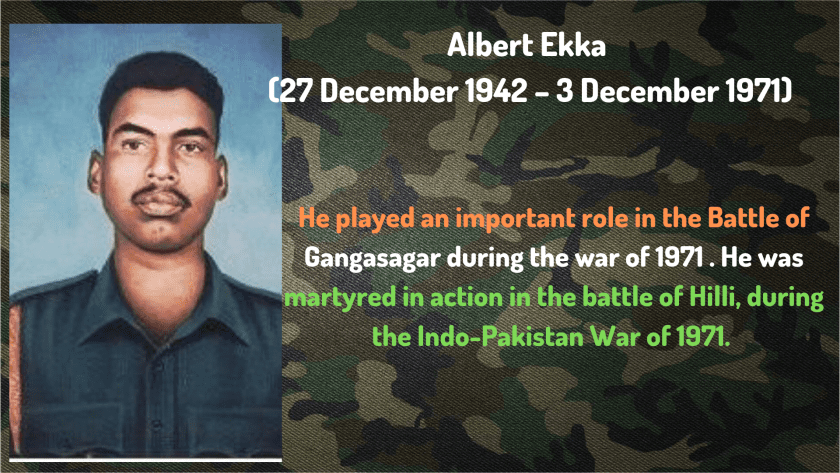
Albert Ekka was born on 27 December 1942, in village Zari, Ranchi, Bihar. His parents were Julius Ekka and Mariam Ekka. Ekka was enrolled in the Bihar Regiment[1] on 27 December 1962.
Ekka was transferred to that unit after the 14th Battalion of the Brigade of the Guards was raised in January 1968.Ekka was promoted to lance naik during the preparation anticipation of Indo-Pakistani war of 1971. He played an important role in the Battle of Gangasagar during the war of 1971 . He was martyred in action in the battle of Hilli, during the Indo-Pakistan War of 1971. He was posthumously awarded the Param Vir Chakra, India’s highest award for valour in the face of the enemy.
In 2000, on the occasion of 50th Republic day, the Government of India issued a postal stamp in his memory. A block (district subdivision) in Gumla has also been created in his name.
Ekka was one important person during the battle of 1971 who made us the winner again. But his loss can never be recovered. India and India will always be debtful to him and his bravery.
III. Arun Khetarpal (14 October 1950 – 16 December 1971):
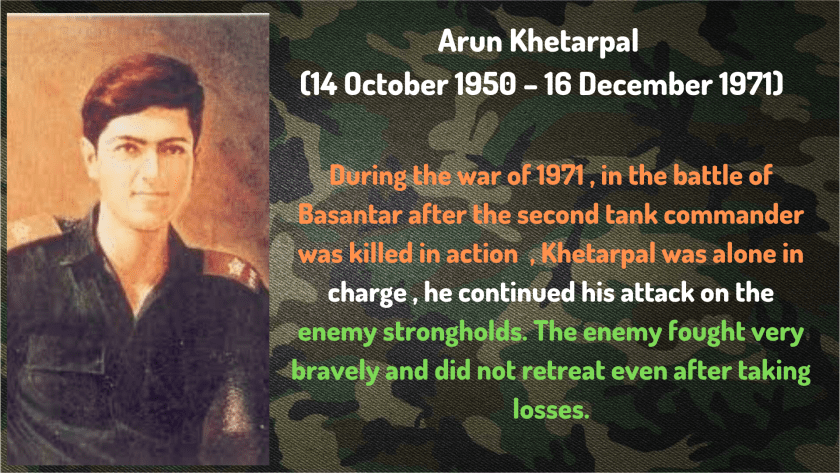
Born in Pune, Maharashtra, Arun Khetrapal was an officer of the Indian Army and a posthumous recipient of the Param Vir Chakra, India’s highest military decoration for valour in face of the enemy. He was killed in action in the Battle of Basantar in the Battlefield of Shakargarh during the Indo-Pakistan War of 1971 where his actions earned him his honour.
His father,M. L. Khetarpal was a Corps of Engineers officer serving in the Indian Army[4] and his family traced a long history of military service. Khetrapal was a perfect schoolboy during his school time , being the best in studies as well as sports. He joined the National Defence Academy in June 1967.He belonged to Foxtrot Squadron where he was the Squadron Cadet Captain of the 38th Course. His NDA No was 7498/F/38. He subsequently went on to join the Indian Military Academy. In June 1971, Khetarpal was commissioned into the 17 Poona Horse.
During the war of 1971 , in the battle of Basantar after the second tank commander was killed in action , Khetarpal was alone in charge , he continued his attack on the enemy strongholds. The enemy fought very bravely and did not retreat even after taking losses. Disappointed by his failure so far, he desperately attacked the incoming Pakistani troops and tanks, knocking out a Pakistani tank in the process. However Pakistani forces regrouped and counter-attacked. In the ensuing tank battle, Lt. Arun Khetarpal with his 2 remaining tanks fought off and destroyed 10 tanks before he was killed in action.The skirmish however took its toll on the lieutenant as he was hit by enemy fire, but instead of abandoning the tank he fought on destroying one final tank before he was finally overwhelmed. However, his actions had denied a vital breakthrough for Pakistani forces and instead put the Indians in a stronger position in the Shakargarh bulge. Then he set about destroying the remaining enemy tanks. The last enemy tank, which he shot, was barely 100 metres from his position.At this stage, his tank received a second hit and he was seriously injured. The officer met his death trying to deny the Pakistani Army its desired breakthrough.
Khetarpal’s body and his tank, named “Famagusta”, were later captured by Pakistan and eventually returned to the Indian military. This tank is on display back in India now. Khetrapal was posthumously awarded with Param Vir Chakra ,India’s most-prestigious and highest-standard military medal for courage and gallantry.
4. The War of Kargil ,1999 :
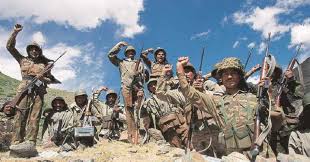
The Kargil War, also known as the Kargil conflict, was an armed conflict between India and Pakistan that took place between May and July 1999 in the Kargil district of Kashmir and elsewhere along the Line of Control (LOC). In India, the conflict is also referred to as Operation Vijay which was the name of the Indian operation to clear the Kargil sector.The Indian Air Force’s role in acting jointly with Ground troops during the War that was aimed at flushing out Regular and Irregular troops of the Pakistani Army from vacated Indian Positions in the Kargil sector along the Line of Controlwas given the code name Operation Safed Sagar .The cause of the war was the infiltration of Pakistani soldiers disguised as Kashmiri militants into positions on the Indian side of the LOC, which serves as the de facto border between the two states.
The war is one of the most recent examples of high-altitude warfare in mountainous terrain, which posed significant logistical problems for the combating sides. It is also one of the very few instances of direct, conventional warfare between nuclear states (i.e., those possessing nuclear weapons). India had conducted its first successful test in 1974; Pakistan, which had been developing its nuclear capability in secret since around the same time, conducted its first known tests in 1998, just two weeks after a second series of tests by India.
Some of the bravehearts of operation Vijay are below mentioned who have been posthumously awarded Param Vir Chakra, Mahavir Chakra and Vir Chakra for their valour and bravery on the battlefield ;
I. Vikram Batra (9 September 1974 – 7 July 1999):
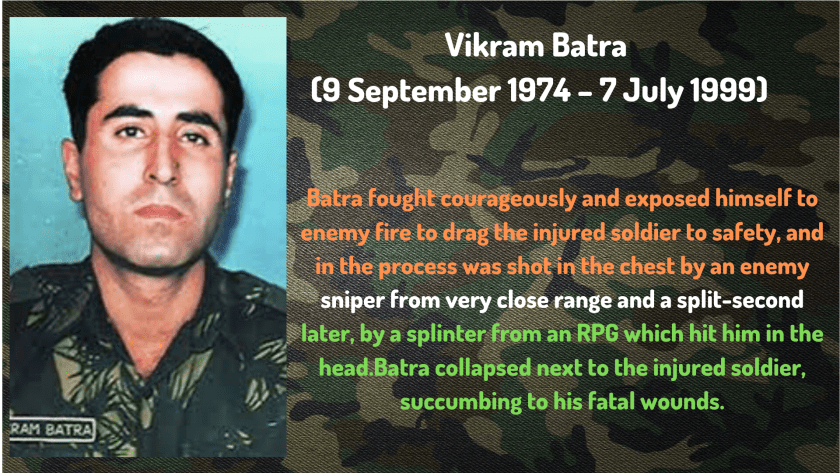
Batra was born on 9 September 1974, in a small town in Palampur, Himachal Pradesh, India. He was the third child of Girdhari Lal Batra, a government school principal, and Kamal Kanta Batra, a school teacher.He got his primary education from his mother, who herself was a teacher.He then attended the D.A.V. Public School in Palampur, where he studied up to middle standard. He received his senior secondary education at Central School, Palampur. Besides being brilliant at studies, Batra was a keen sportsman and represented his school at the national level during the Youth Parliamentary competitions at Delhi. He excelled at many sports and represented his school and college in table tennis, Karate and other such games. At college, he joined the Air Wing of the National Cadet Corps (NCC) while he was in the first year.During the Inter-State NCC Camp, he was adjudged the best NCC Air Wing cadet of Punjab Directorate in North Zone.
In 1996, he passed the CDS examination and subsequently received a call for interview at the Services Selection Board (SSB) at Allahabad and got selected. He was among the top 35 candidates in the Order of Merit.After completing a year (session 1995—96) toward the degree of MA in English, he left the University to join the Indian Military Academy. Batra joined the Indian Military Academy (IMA) at Dehradun in June 1996 in the Manekshaw Battalion.[19] After completing his 19-month training course, he passed out from the IMA on 6 December 1997 and was commissioned as a lieutenant into the 13th battalion, Jammu and Kashmir Rifles (13 JAK RIF).[20] After commissioning, he was sent to the regimental centre in Jabalpur, Madhya Pradesh for further training. The training lasted one month, from December 1997 to the end of January 1998.
Batra last came home on leave from the army in 1999, during the Holi festival for a few days. After his leave, he returned to join his battalion in Sopore. 13 JAK RIF, after completing its counter-insurgency tenure in Kashmir under 192 Mountain Brigade of 8 Mountain Division, received orders to proceed to Shahjahanpur, Uttar Pradesh. The battalion’s advance party under Maj. Yogesh Kumar Joshi had reached its destination, when on 5 June, because of the outbreak of the Kargil War, its deployment orders were changed and the battalion received orders to move to Dras, Jammu and Kashmir.Batra informed his parents about his movement and assured them that they need not worry about him.He would call his parents at least once in ten days. The last phone call he made was on 29 June 1999. Without Captain Batra it was impossible to capture the point 5140 and Point 4875 .On the night of 6–7 July, the opposing forces were so close that besides exchanges of small arms fire, verbal exchanges continued throughout the night.[65][74] It was at this stage that it became imperative for Indian troops to destroy this Pakistani post, located north of Point 4875, from where enemy fire was coming as otherwise the situation could get worse. Batra fought courageously and exposed himself to enemy fire to drag the injured soldier to safety, and in the process was shot in the chest by an enemy sniper from very close range and a split-second later, by a splinter from an RPG which hit him in the head.Batra collapsed next to the injured soldier, succumbing to his fatal wounds.
Vikram Batra was awarded the Param Vir Chakra, India’s highest military honor on 15 August 1999, the 52nd anniversary of India’s independence. His father G.L. Batra received the honor for his deceased son from the President of India, the late K. R. Narayanan.
Vikram Batra is also well known in India for using the slogan, Yeh Dil Maange More! as his signal to communicate mission success. He was known as Sher Shah , (“Lion King”) in the intercepted messages of the Pakistan Army.
The character of Captain Vikram Batra has been portrayed by Abhishek Bachchan in the Hindi Film LOC Kargil (2003) which was based on entire Kargil Conflict.
II Anuj Nayyar (August 28, 1975 – July 7, 1999) :
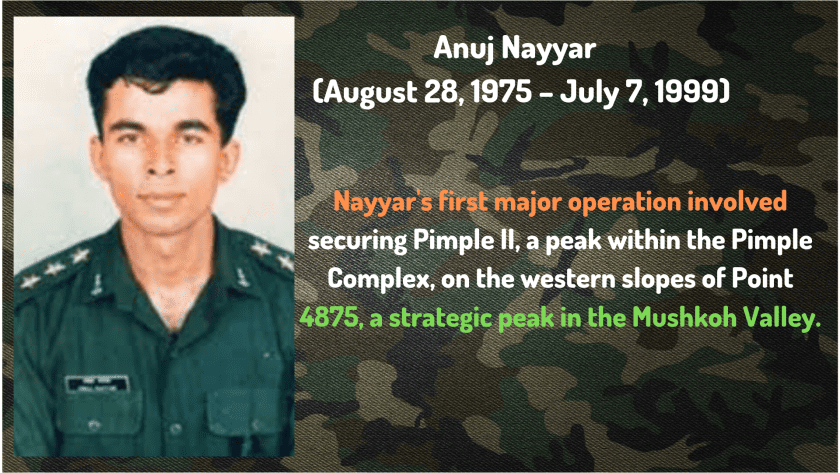
.Captain Anuj Nayyar, was an Indian Army officer of 17 Jat who was posthumously awarded the Maha Vir Chakra, India’s second highest gallantry award, for exemplary valour in combat during operations in the Kargil War in 1999.Anuj Nayyar was born and grew up in Delhi, India. His father, S.K. Nayyar, worked as a visiting professor in Delhi School of Economics while his mother, Meena Nayyar, worked for the South Campus library of Delhi University.Nayyar received his high-school education from Army Public School, Dhaula Kuan .He was a bright student who consistently performed well in academics and sports. He graduated from the National Defence Academy (90th course, Echo Squadron) and later was commissioned into the 17th battalion, Jat Regiment (17 Jat) in June 1997 from the Indian Military Academy (100 Reg).
In 1999, the Indian Army detected a massive infiltration by Pakistani military and paramilitary forces in the Kargil region of Jammu and Kashmir. The army quickly mobilized its forces to drive out the Pakistani infiltrators from Indian territory. 17 Jat was one of the battalions deployed in the region. Nayyar’s first major operation involved securing Pimple II, a peak within the Pimple Complex, on the western slopes of Point 4875, a strategic peak in the Mushkoh Valley.
During the initial phase of C Coy’s assault on Pimple II, Nayyar’s company commander was injured, and command devolved upon him. As the unit advanced under heavy enemy artillery and mortar fire, the lead section reported the location of 3-4 enemy bunkers. Nayyar moved forward and destroyed the first bunker with a rocket launcher and grenades. Still under heavy fire, he then proceeded with the lead section, which consisted of 7 personnel, and destroyed two more bunkers.[1] During the battle, Nayyar killed 9 Pakistani soldiers and destroyed three medium machine gun bunkers.[2] The company then began its assault on the last remaining bunker, but while clearing it, an enemy RPG directly hit Nayyar, killing him instantly.[3][4]
During the entire battle for Pimple Complex, 46 regular members of the Pakistan Army, an unknown number of Pakistani paramilitary troopers and militants, and 11 Indian Army troops, including Capt. Nayyar, were killed.[5] The securing of Pimple Complex paved the way for the recapture of Tiger Hill which finally forced Pakistan to retreat back across the Line of Control.
Nayyar was posthumously awarded the Maha Vir Chakra for his bravery and leadership in combat.
The character of Anuj Nayyar was portrayed by Saif Ali Khan in the Hindi film LOC Kargil (2003). The film is entirely based on the Kargil Conflict.
India can never forget these brave hearts who gave their lives for the sake of the safety and freedom and divinity of the Mother Nation. We owe our every day to these soldiers, their bravery and courage has made India what it is today without them, independent India would have been a dream.
Truly said :
“There are never any victors in war; both sides lose and it is the families that have to pay the price and suffer the most. As someone once said ‘Wars are created by politicians, compounded by bureaucrats and fought by soldiers.”
सर झुके बस उनकी शहादत में ,
जो शहीद हुए हमारी हिफाज़त में ।
Jai hind!Jai Bharat !

